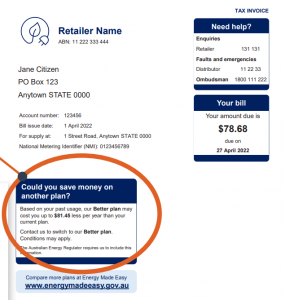Aussie bill-payers will soon be informed whether they could be on a better energy offer from their power company, thanks to a new guideline introduced by the regulator.
The Australian Energy Regulator (AER) will mandate the Better Bills Guideline in 2023 that will require electricity and gas retailers to notify customers on their bills if there’s a better offer, as well as how to switch. The rule change will take effect in New South Wales, Queensland, South Australia, ACT and Tasmania.
It’s part of a move that’s aimed to make energy bills simpler for consumers, which will feature a compulsory ‘better offer’ statement on the first page of a bill. This is expected to be placed under a heading that notes, ‘Could you save money on another plan?’.
AER Chair Ms Clare Savage said the Better Bills Guideline is about making it easier for consumers to engage in the energy market, which can help them make better informed purchase decisions.
“Over time, energy bills have become more complex and detailed, and our research revealed that this can reduce understanding and create confusion,” Ms Savage said.
“Our purpose as a regulator is to make energy consumers better off now, and in the future, and this new industry requirement for simpler energy bills goes to the heart of this.”
According to the AER, not only will bill-payers need to be informed if they’re getting a good deal, but retailers will also have to supply information about switching, including if any conditions apply.
The AER stated the guideline provides the exact wording for retailers to apply onto bills, which is expected to come into effect from 31 March 2023.
It follows changes in Victoria where ‘best offer’ messaging was implemented last year to help less-engaged customers shop around for a better deal.
Compare Electricity Plans
Here are some of the cheapest published deals from the retailers on our database that include a link to the retailer’s website for further details. These are products from referral partners†. These costs are based on the Ausgrid network in Sydney but prices may vary depending on your circumstances. This comparison assumes general energy usage of 3900kWh/year for a residential customer on a single rate tariff. Please use our comparison tool for a specific comparison in your area. Our database may not cover all deals in your area. As always, check all details of any plan directly with the retailer before making a purchase decision.
Here are some of the cheapest published deals from the retailers on our database that include a link to the retailer’s website for further details. These are products from referral partners†. These costs are based on the Citipower network in Melbourne but prices may vary depending on your circumstances. This comparison assumes general energy usage of 4000kWh/year for a residential customer on a single rate tariff. Please use our comparison tool for a specific comparison in your area. Our database may not cover all deals in your area. As always, check all details of any plan directly with the retailer before making a purchase decision.
Here are some of the cheapest published deals from the retailers on our database that include a link to the retailer’s website for further details. These are products from referral partners†. These costs are based on the Energex network in Brisbane but prices may vary depending on your circumstances. This comparison assumes general energy usage of 4600kWh/year for a residential customer on a single rate tariff. Please use our comparison tool for a specific comparison in your area. Our database may not cover all deals in your area. As always, check all details of any plan directly with the retailer before making a purchase decision.
Here are some of the cheapest published deals from the retailers on our database that include a link to the retailer’s website for further details. These are products from referral partners†. These costs are based on the SA Power network in Adelaide but prices may vary depending on your circumstances. This comparison assumes general energy usage of 4000kWh/year for a residential customer on a single rate tariff. Please use our comparison tool for a specific comparison in your area. Our database may not cover all deals in your area. As always, check all details of any plan directly with the retailer before making a purchase decision.
Energy bills should be ‘precise, simple, accessible and understandable for everyone’
Research conducted by the AER found that consumers want a uniformed approach to energy billing from retailers, with important details easier to navigate for every type of customer, especially those in financial hardship or who may have lower levels of literacy. More than 14,000 Australians tested the bill requirements, with input gathered from retailers, consumer groups and energy ombudsman schemes, Ms Savage explained.
“Our research told us that customers ‘would love to see if there was a different plan available that would potentially save [them] more money’ and that ‘bills should be precise, simple, accessible and understandable for everyone’. As one customer puts it, they would like a bill that is ‘uncluttered and easy to understand and gives a good picture of where the costs, discounts and credits are coming from.’
“We’ve listened and we have taken a tiered approach to information, restricting the amount of content allowed on the first page to ensure simple, clean design. At first glance, this will give customers the essentials and tell them whether they might switch and save. That’s a great outcome for consumers.”
Here is an example from the AER of what the ‘better offer’ messaging will look like on a bill:

How well-informed is the average energy customer in Australia?
Recent Canstar Blue research uncovered that only 22 per cent of Australians think they have a good understanding of the electricity market in their state, while less than half (47%) knew what the default price offer means. These are default electricity tariffs which serve as a price cap for energy retailers, while also acting as a reference point for customers to compare prices from. It is known as the ‘Reference Price’ in New South Wales, south-east QLD, South Australia and the ACT, and the ‘Victorian Default Offer (VDO)’ in Victoria.
Furthermore, the findings also revealed that 38 per cent of survey respondents knew what their electricity usage rates and supply charges were. These are the base rates all Australians pay to use power and have electricity supplied to their home via the grid.
Image credit: Antonio Guillem/Shutterstock.com, Australian Energy Regulator


Share this article